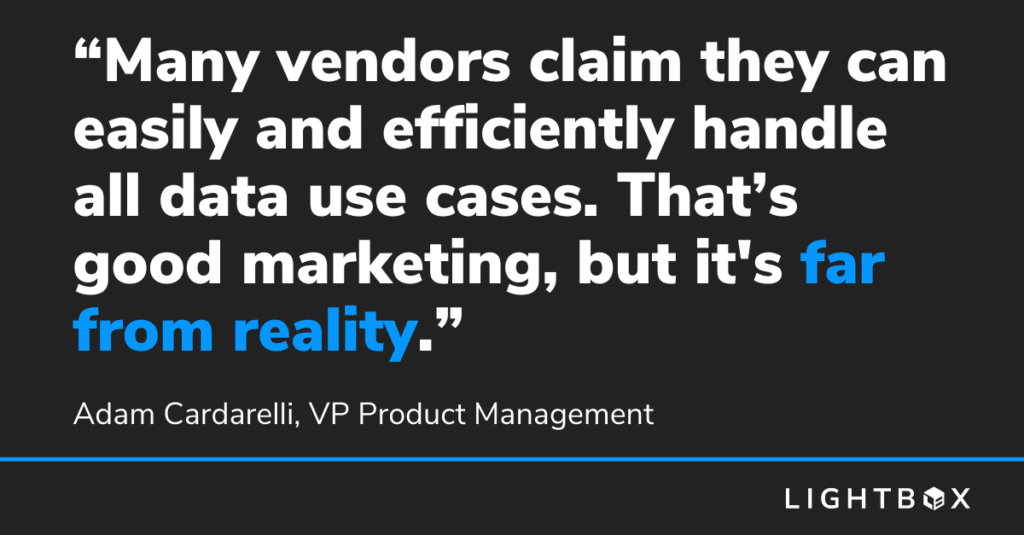1. A new LightBox unified data platform will significantly improve users’ decision-making capabilities
2. The platform uses identifiers in a new way, bringing together spatial and non-spatial relationships to improve data connectivity
3. Using the financial services industry as a model, we want to offer powerful analysis, nanosecond delivery, and the ability to leverage historical data
“Big Data” was once seen as the key to solving modern business challenges. The Internet and a range of new technologies spawned new ways to collect vast troves of information, from the shopping habits of mobile phone users to the number of shipping containers in a port awaiting transport. But data alone, even in large quantities, isn’t enough—it must be interpreted, connected, analyzed, and manipulated to prove useful. It’s not about quantity, it’s about tapping the full potential of data to derive valuable information.
To meet this challenge, my team at LightBox is building a unified data platform that has modernized the way we onboard disparate sources of data to a connected data fabric that can be easily accessed through a set of cloud-based APIs that will significantly improve decision-making in site selection and evaluation, portfolio management, risk analysis, and planning. Accessible through the LightBox Developer Portal, clients can evaluate the APIs ahead of purchase and access educational material about data.
The real estate sector faces numerous challenges related to data management—data is often not available, it must be connected, and it may be outdated or not granular enough. It’s difficult to get the kind or 360 degree view for analysis that allows businesses to confidently act. One problem is that much of the data in the commercial real estate industry is trapped in silos or frameworks that cannot be connected. Some of it is inconsistent, making it hard to analyze, creating hurdles for users seeking to develop applications, analytics, data science, and automation. Customers say that in many cases a lot of effort is required for them to carry out even a simple analysis.
We want to change that. The new LightBox data platform will help brokers, buyers, lenders, appraisers, and environmental professionals who rely on us transform the way they analyze information and breathe new life into their workflow models. Many industry professionals are frustrated about the disconnect between the available data and the ability to harness it quickly to create actionable insights before the opportunity they’re seeking is gone.

A Fresh Approach to Accessing and Analyzing Data with Reliable Identifiers
In today’s market, customers want to blend traditional content with unconventional or alternative data. For example, environmental, social, and governance (ESG) investors need accurate, timely data about climate. This sort of dataset is relatively new to commercial real estate and a lot of people are trying to figure out how to incorporate it into their decision making. A lack of awareness about these new datasets is coming up as a pain point in discussions with clients.
Another issue is that there are no commonly accepted standards related to data definitions, governance, and identifiers. Users looking at a new property may realize it’s an existing property they’ve already researched. There is no commonly adopted way to identify it other than an address, and these aren’t always accurate or even available. Time spent seeking this basic information could be better spent on in-depth research in other areas. Finding basic data shouldn’t be a difficult, time-consuming task. Reliable identifiers are game-changers.
With our new platform, LightBox decided to take a fresh approach to identifiers. Most identifiers are based on addresses, but these change over time, making it difficult to maintain linkages. To solve for this, when we link and connect disparate datasets with a common standard we look not just at spatial relationships based on an address, but at non-spatial relationships and at how that identifier connects to other identifiers in the ecosystem, whether they are provided by our partners or internally. The LightBox identifier is designed to be unique and persistent over time. For example, you can identify whether there is a subdivision within a parcel or whether a property’s address has changed.

Meeting the Widest Possible Variety of Needs by Combining Cutting-Edge Tech and Powerful Data
Many vendors claim they can easily and efficiently handle all data use cases. That’s good marketing, but it’s far from reality. Additionally, having data in the cloud is not sufficient in and of itself—it is only one step in the process of creating a modern platform. One size does not fit all when it comes to data and technology. A vector-based dataset may be modeled differently from raster, or tabular data differently from opaque data coming from documents. Users need the technological components to access and manage this according to their own specifications.
I have spent my career analyzing and manipulating data to solve problems, working with increasingly large datasets. The commercial real estate industry can learn from the financial services industry, which is skilled at manipulating and analyzing data, enjoys nano-second delivery, and leverages historical information to help predict the future. Data moves more slowly in commercial real estate and combining it has been a challenge. No two regions—states, counties, municipalities—are exactly alike. They don’t track the same datasets and they have different zoning rules and demographics. Our new platform will consistently deliver that diverse body of data in a usable fashion. It will meet the widest possible variety of needs of everybody in the industry—buyers, sellers, lenders, appraisers, environmental professionals, etc.—who can scale it according to need.
Data and technology are constantly evolving. We’re bringing the best of both worlds together to pave the way for the commercial real estate industry to step boldly into the future.

